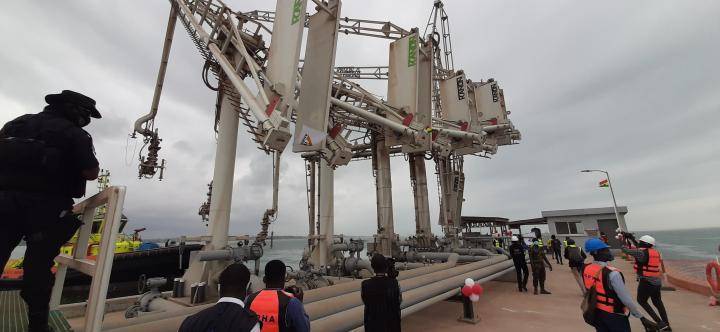A new liquid bulk terminal has been inaugurated by the Vice President of Ghana, Dr. Mahamudu Bawumia, at the Takoradi Port in the Western Region of the West African country. The construction of the facility was initiated by Ibistek Ghana Limited in March 2018, at the cost of US$ 56M with funding from the Ghana Infrastructure Investment Fund and the Consolidated Bank Ghana.
It consists of a 14m-water depth berth that is reportedly the deepest in-harbor berth in the country, a loading arms for five petroleum products which are petrol, diesel, LPG-gas, bitumen, and other heavy fuels, full berthing structures including fenders on dolphins, bollards, and hooking points.
Also Read: Ghana to begin construction of Keta seaport next year
Furthermore, the terminal is designed to support vessels with a capacity of up to 60,000 tons of petroleum. A header station, where all the pipes terminate has also been developed so that importers can connect to receive their various liquid cargos.
The project is expected to meet more than 50 percent of Ghana’s domestic petroleum consumption demands.
The second phase construction of the dry bulk terminal at the Port of Takoradi
On the sidelines of the inauguration of the new liquid bulk terminal, the Vice President also cut the sod for the construction of the second phase of the dry bulk terminal under construction at the same maritime facility.
The dry bulk terminal project is being carried out by Amandi Investments Limited, at a cost of US$ 70M. Basically, the terminal is an 810-meter long wharf facility for three large ore carriers that will be served by loaders or unloaders and conveyor systems. It is designed to handle increased volumes of bauxite, manganese, and all the cement-related cargos such as clinker, gypsum, limestone, lime, furnace slag, and other new bulk cargoes that may emerge within the market space. The targeted capacity is 18.5 million metric tons of cargo per year from the current 6.5 million metric tons.
The superstructure works are expected to be completed by the second quarter of 2022.
